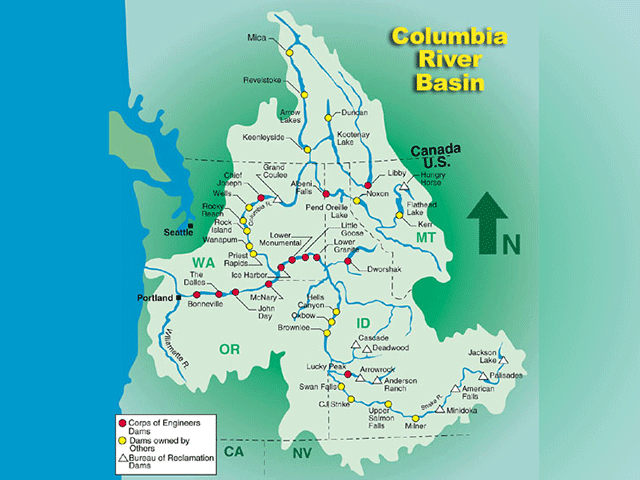Market Matters Blog
Will Extended Lock Closures on Columbia and Snake Rivers Disrupt Exports?
The U.S. Army Corps of Engineers (USACE) Walla Walla District is closing navigation locks on the Columbia and Snake rivers beginning Jan. 14, 2024, for an 11-week outage. "This extended outage will allow the district to perform routine maintenance and to replace aged equipment to reduce the risk of asset failure," notes USACE on their website.
USACE officials anticipate the four navigation locks included in this extended outage will return to service by March 29, 2024, at 11:59 p.m.
"The navigation locks included in the extended outage are McNary Dam, located at river mile 292 of the Columbia River, and Lower Monumental Dam, Little Goose Dam and Lower Granite Dam, located on the Snake River at river miles 41, 70 and 107, respectively," said USACE.
Jeff Van Pevenage, president and CEO Columbia Grain, Portland, Oregon, told DTN in an email the maintenance being performed on the system is "important for the long-term viability of the cheapest, most carbon friendly transportation system in the United States. It is not coming as a surprise as it's been well planned and communicated. For what it's worth, they would anticipate another long-term closure in 2030.
"The system has been preparing for this closure by moving inventories of upper river grain into the Portland Marketplace at a heavier pace than normal over the past 30 days. Additionally, Tidewater and Shaver barge lines have done an excellent job of providing extra storage barges to allow the marketplace to move grain but not be forced to sell it and take on more risk than necessary."
Van Pevenage said, "This year it's a bit fortunate that the demand is not taxing, so between the early shipments, storage space being utilized in export terminals that are operating below ideal capacity levels in the Columbia River Datum (CRD), and the utilization of rail facilities in the Pacific Northwest (PNW), it's a manageable closure."
P[L1] D[0x0] M[300x250] OOP[F] ADUNIT[] T[]
He added, "The risk for the PNW today is extra business showing up in the next 45 days for soft white wheat (SWW). Given the situation in the Panama Canal, we are seeing more corn and soybean business being directed to the PNW and that has actually brought about some South American soft wheat demand in the February and March window, so if markets perk up, the additional needs will have to be met by rail shippers. Much of the Palouse and Camas Prairie, Idaho, grain is grown in areas that don't have easy rail access, so shipping costs for some farmers will likely increase."
As for the export side, Van Pevenage noted they will incur more storage costs as "we have had to front-end load the program/hold more SWW inventory at Columbia Export Terminal and Kalama as compared to normal one month river closure. We might possibly face increased execution costs (i.e. vessel demurrage) on the hard red winter and spring wheat programs as barges often help us fill in gaps when rail shipments are delayed."
Van Pevenage told me they have tried to supplement the loss of barges by purchasing more rail. "In addition, where possible, we have tried to target sales prior to and at the end of the closure. We have worked closely with barge loaders to coordinate the timing of shipments and use of storage barges."
U.S. Wheat Associates noted in a recent update about the closure that about 75% of annual PNW soft white (SW) and club wheat exports are barged on the Columbia Snake River System (CSRS) and Willamette Rivers. "Similar extended closures occurred in 2010 and 2016. This maintenance to be performed represents a forward-thinking investment by the U.S. Army Corps of Engineers to assure this critical waterway remains operational for decades to come. The additional improvements will help the U.S. wheat export supply system remain the most reliable in the world."
I asked Byron Behne, senior marketing manager, Northwest Grain Growers, Walla Walla, how the closure may affect NWGRGR and he said, "It affects what we can load. Everything above McNary on the Columbia will be closed through the middle of March. Normally, the annual closure is two weeks in March. Points below McNary will be able to load as normal until the regular two-week closure in March. Not a huge deal this year now that there are more shuttle loaders around and demand for white wheat is poor."
Behne added, "The thing that could make things interesting is if China wanted to cancel some soft red wheat and replace with white wheat; that would be tough to flip a bunch of volume for during the closure."
Link to USACE Walla Walla about lock closure: https://www.nww.usace.army.mil/…
Link to U.S. Wheat Associates Dec. 4 update to wheat buyers:
Information on the Columbia Snake River system: https://www.pnwa.net/…
Mary Kennedy can be reached at mary.kennedy@dtn.com
Follow her on X, formerly known as Twitter, @MaryCKenn
(c) Copyright 2024 DTN, LLC. All rights reserved.






Comments
To comment, please Log In or Join our Community .